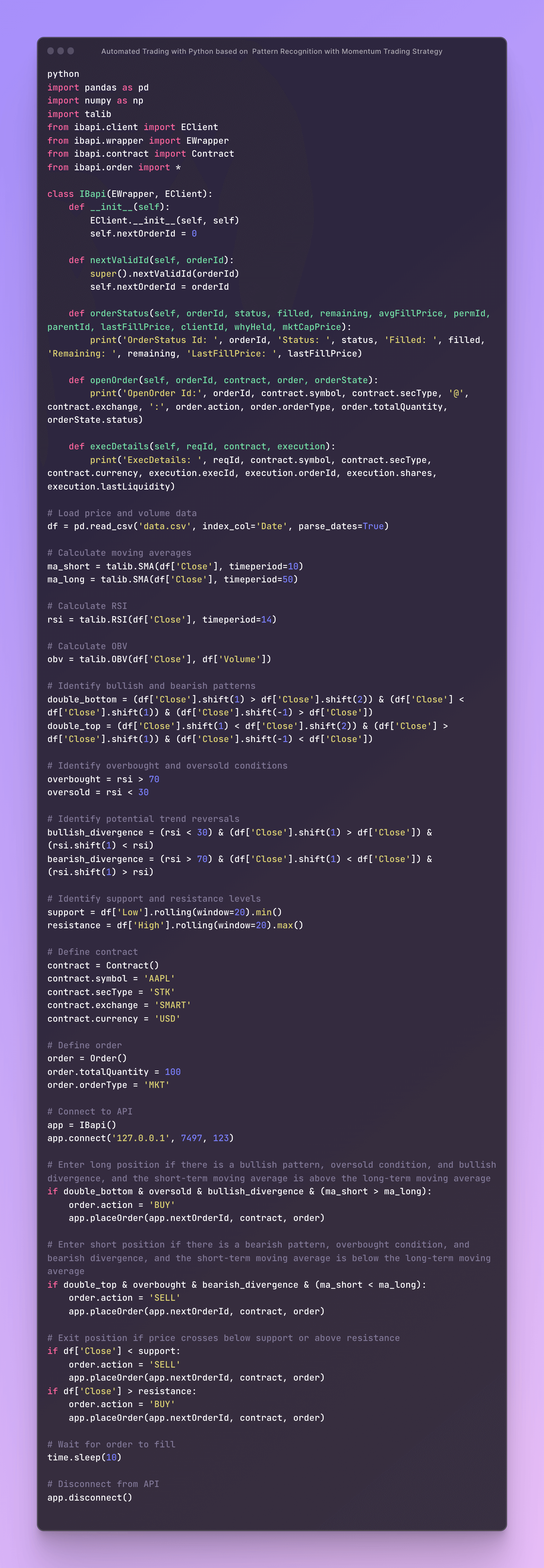
Algorithmic Trading: Combining Pattern Recognition, Momentum Trading Strategy, and Price Action in Python
27 October, 2023
Algorithmic trading is a widely used approach for trading in financial markets. It involves the creation of statistical and mathematical trading strategies using computer programs called trading algorithms. This article outlines the process of developing an algorithmic trading strategy that combines pattern recognition, momentum strategy, price action, and volume analysis using Python.
Steps to Create an Algorithmic Trading Strategy
1. Pattern Recognition
Begin by employing technical analysis to identify patterns within a security's price and volume data. For instance, you can utilize tools like moving averages, Bollinger Bands, or candlestick patterns to spot trends, support and resistance levels, and potential breakouts.
2. Momentum Strategy
Utilize momentum indicators like the Relative Strength Index (RSI) or the Moving Average Convergence Divergence (MACD) to identify conditions of overbuying or overselling and anticipate potential reversals in trends.
3. Price Action
Employ price action analysis to identify significant levels of support and resistance while gauging the strength of a trend. You can recognize potential trading opportunities by analyzing price action patterns like double tops and bottoms, head and shoulders, or triangles.
4. Volume
Use volume analysis to validate price movements and detect potential trend reversals. Volume indicators such as On-Balance Volume (OBV) or Chaikin Money Flow (CMF) can help identify buying or selling pressure.
To implement these steps, Python libraries like NumPy, pandas, and Matplotlib can be of great help. Moreover, there are specialized Python libraries designed for algorithmic trading, such as Backtrader and Zipline. The library I will be using for this example is Talib which is helpful when computing technical indicators such as MA and RSI directly from price time series.
Combining Strategies for Enhanced Signal
By combining all these strategies, we can generate stronger trading signals. Here's an example of how you can combine Pattern Recognition with Momentum Trading Strategy using Python:

In this code, we integrate the four strategies discussed earlier, namely Pattern recognition, Momentum strategy, Price action, and Volume analysis. We identify bullish and bearish patterns, overbought and oversold conditions, potential trend reversals, and support and resistance levels. We then establishes long or short positions based on these conditions and the relationship between short-term and long-term moving averages. Additionally, the code implements position exits if the price crosses below support or above resistance.
However, it's essential to note that this code is solely an illustrative example and should not be used for live trading without adequate backtesting and risk management.
Automating Process with Broker API

The code example above integrates strategies for algorithmic trading. We utilize the IB API to establish a connection with a trading platform and execute orders based on identified trading opportunities.
We first load price and volume data, computing moving averages, RSI, and OBV, and identifies bullish and bearish patterns, as well as overbought and oversold conditions. We then recognizes potential trend reversals and support/resistance levels.
Once we identify the Market regime, we initiate long or short positions based on these conditions and the relationship between short-term and long-term moving averages. Additionally, we close positions when the price crosses below support or above resistance levels.
Conclusion
Algorithmic trading presents a powerful approach for engaging in financial market activities. Gaining an advantage in this field can be particularly challenging due to its intense competition. In this article, I have illustrated an example of combining not just one, but multiple strategies to facilitate well-informed decision-making. By adeptly combining pattern recognition, momentum strategy, price action, and volume analysis using Python, you can craft resilient trading strategies that enhance your decision-making capabilities and, in turn, potentially lead to improved trading outcomes.